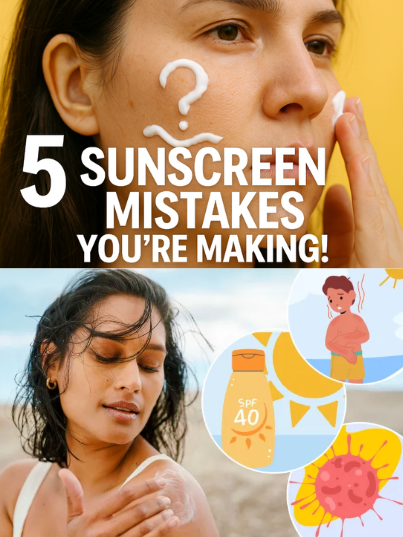
Protecting your skin from the sun isn’t just about avoiding sunburn. Sunscreen is your first defense against wrinkles, premature aging, and even skin cancer. But here’s the kicker—most people don’t apply it correctly. Applying sunscreen incorrectly leaves your skin exposed and unprotected, no matter how high the SPF on the bottle. In this guide, we’ll walk through the common sunscreen mistakes, how to fix them, and what to look for in the right formula.
Why Sunscreen Is More Than Just SPF
We all know sunscreen blocks UV rays, but did you know it also offers anti-aging benefits? From reducing dark spots to maintaining collagen, sunscreen is a daily shield for your skin. However, if applied incorrectly, it fails to deliver these benefits. Understanding proper application is key to keeping your skin healthy, youthful, and radiant.
1. Mixing Sunscreen with Other Products
Many people think mixing sunscreen with moisturizer or foundation is a clever shortcut. But it’s not. Mixing can dilute the SPF, reducing its effectiveness. For example, if your sunscreen is SPF 30, blending it with another product may lower protection to SPF 15.
Moreover, some ingredients in your skincare or makeup can interfere with UV filters, leaving your skin vulnerable to sun damage, dark spots, and wrinkles. Even mixing mineral and chemical sunscreens can create negative interactions, potentially causing irritation.
Pro Tip: Always apply sunscreen last in your morning routine. Layer other products underneath instead of mixing. This ensures your skin gets maximum protection.
2. Applying Sunscreen Only Once a Day
Many assume morning application lasts all day—but it doesn’t. UVA and UVB rays continuously affect your skin. If you’re near windows, driving, swimming, or sweating, the sunscreen can wear off faster than you think.
Dermatologists recommend reapplying every two hours or more frequently if you’re outdoors or active. Even water-resistant formulas need reapplication after swimming or heavy sweating. Remember: one application is rarely enough to fully protect your skin throughout the day.
Video : My Top 5 Sunscreen Mistakes & How To Fix Them
3. Ignoring Sunscreen Indoors
Think sunscreen is only for the beach? Think again. Blue light from phones, computers, and tablets can damage your skin by producing reactive oxygen species that break down collagen and trigger pigmentation.
Pro Tip: Choose a broad-spectrum sunscreen with UVA, UVB, and blue light protection. Ingredients like zinc oxide and iron oxide shield your skin from harmful rays and high-energy visible light indoors.
4. Not Applying Enough Sunscreen
Under-application is a common error. Experts recommend about one ounce of sunscreen for full-body coverage, but most people use less than a quarter of that amount. For the face, a nickel-sized amount is usually sufficient.
Don’t forget areas like the neck, ears, ankles, and feet—these are commonly missed spots prone to sun damage. Being generous with your application ensures you get the SPF protection stated on the bottle.
5. Overlooking SPF and PA Ratings
Not all sunscreens are created equal. SPF measures UVB protection, while the PA rating indicates UVA protection. Many sunscreens lack sufficient UVA defense, leaving your skin at risk for premature aging.
Pro Tip: Choose products with SPF 30 or higher and a high PA rating. This ensures maximum broad-spectrum protection for everyday use.
Choosing the Right Sunscreen for Your Skin
Know Your Skin Type: Sunscreen formulas vary depending on skin type. Ingredients like zinc oxide, titanium dioxide, and physalis angulata extract are gentle and antioxidant-rich, suitable for all skin types. Oily or acne-prone skin benefits from tocopheryl acetate (Vitamin E) for anti-irritation. Sensitive skin requires hypoallergenic, fragrance-free formulas.
Avoid Harmful Ingredients: Steer clear of oxybenzone, parabens, PABA, and alcohol, which can harm the skin and the environment. Non-comedogenic sunscreens prevent clogged pores and allow your skin to breathe.
Video : Sunscreen mistakes you’re probably making
The Key Takeaway
Sunscreen is not optional—it’s essential. But applying it incorrectly can compromise its benefits, leaving your skin exposed to sun damage, premature aging, and wrinkles. Avoid mixing products, reapply throughout the day, use adequate amounts, and choose broad-spectrum formulas suited for your skin type. By following these guidelines, you can enjoy the full protective benefits of sunscreen and keep your skin looking youthful and healthy.


